This article presents data on emergency and commercial oil stocks in the European Union (EU). Crude oil and petroleum products play a very important role in the economy of the European Union and, given the oil import dependency of the EU, holding emergency oil stocks is very important for the energy security of the Union. Commercial stocks can also be fundamental in times of need and therefore are included in the assessment of the overall stock holding situation.
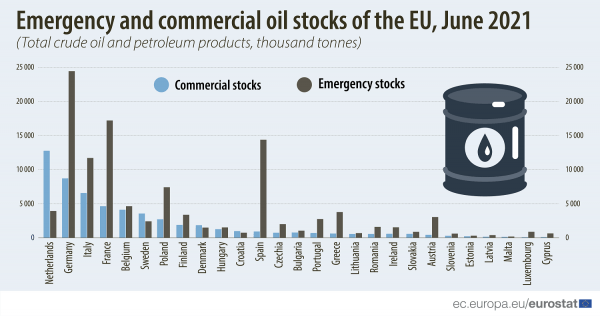
Emergency oil stocks statistics
Crude oil and petroleum products play a very important role in the economy of the European Union, particularly in the transport sector and the petrochemical industry. Given their important role and the oil import dependency of the EU, holding emergency oil stocks is very important for the energy security of the Union. To guarantee these stocks, the relevant EU law, Council Directive 2009/119/EC imposes an obligation on Member States to maintain minimum emergency stocks of crude oil and petroleum products. Member States are required at all times, to maintain oil stocks equivalent to at least 90 days of average daily net imports or 61 days of average daily inland consumption, whichever of the two quantities is greater. Eurostat publishes the monthly emergency oil stocks levels in physical quantities as well as in days equivalent.
The EU emergency oil stocks
Table 1 presents the emergency oil stocks of each EU Member State as well as of the European Union. In June 2021, the EU countries held 112.5 million tonnes of emergency oil stocks. The largest stocks are for crude oil (47.4 million tonnes in the EU), followed by gas/diesel oil (40.0 million tonnes) and gasoline (10.0 million tonnes). The composition of the emergency stocks by fuels is a decision taken by each country and it varies as seen in the table below.
Emergency oil stocks held abroad
Member States can hold their emergency oil stocks in their own territory or in other EU Member States. In June 2021, 12 % of emergency stocks in the EU were held in other Member States. National procedures differ very much in this regard. Five Member States kept all their emergency stocks in their territory: Greece, Hungary, Poland, Slovakia and Finland. 22 Member States held part of their emergency stocks in the territories of other Member States. The country with the biggest share of oil stocks held abroad was Luxembourg (93 %), followed by Malta (81 %) and Belgium (65 %). Figure 1 presents the amounts of emergency oil stocks held domestically and abroad for each Member State, moving from left to right in the figure the proportion of the stocks held abroad increases.
Emergency oil stocks in days equivalent
Member States are required at all times to maintain oil stocks amounting to at least 90 days of average daily net imports or 61 days of average daily inland consumption, depending on which of the two quantities is greater. The 90 days net imports method generally applies to Member States who are heavily import dependent. The 61 days inland consumption method normally applies to Member States that produce crude oil and oil shale and for which domestic production contributes to the security of supply. The inland consumption method can also apply to Member States with very significant petrochemical industry such as the Netherlands.
The method applied can change in July of each year, when the obligations are recalculated based on the production and imports/exports data of the previous year.
Table 2 presents the emergency oil stocks in days equivalent, according to the methods applied in the calculation. In June 2021, 25 Member States kept oil stocks based on net imports. Out of them seven Member States were below the 90 days requirement (marked in red below). Two Member States kept stocks based on inland consumption and both were above the required 61 days. Countries below their obligations must justify the situation and work on re-establishing the required levels.
Commercial stocks
According to the Directive, countries must also report most of their commercial stocks, as they are physically available and might be called upon in a crisis. Specifically, they must report those stocks held by economic operators in the national territory for their own operational and commercial needs which therefore can be considered available, in addition to the emergency stocks, in case of need.
In June 2021, the commercial stocks in the EU were 55 145 kt and accounted for 33 % of the total stocks (167 651 kt) reported under the Directive. Figure 2 shows the situation in the different EU Member States.
While emergency stocks are quite stable as they reflect obligations that are calculated on an annual basis, commercial stocks in the territory may fluctuate according to market trends.
In 2020, due to the COVID-19 related measures restricting movements and transport, the demand for several fuels decreased significantly (March 2020, April 2020, August 2020) and consequently stocks increased in many countries sometimes to the limits of maximum storage capacity. In June 2020, in the middle of the storage constraint period, in the EU (excluding data for Germany, the Netherlands and Sweden for lack of historical data) the commercial stocks had increased by 18.3 % compared with the same month in the previous year.
In the following months, the demand for oil products started slowly normalising and commercial stocks started adjusting arriving at – 8.4 % in June 2021 compared with the same month in 2020. These values remain volatile however, as they are influenced by many factors such as spot prices, OPEC+ decisions, policy announcements, and refineries’ choices.
The Member States with the largest percentage difference in June 2021 compared to the same month in the previous year were Greece (+ 286 % in 2020, – 61 % in 2021), Estonia (+ 197 % in 2020, – 51 % in 2021) and Denmark (+ 97 % in 2020, – 33 % in 2021). In terms of quantities, the Member States with the largest changes were Italy (+ 1 963 kt in 2020, – 1 085 kt in 2021), Denmark (+ 1 293 kt in 2020, – 874 kt in 2021) and Greece (+ 1 116 kt in 2020, – 916 kt in 2021). The figure below presents the commercial oil stocks changes both in quantities and percentages, in June 2020 and in June 2021 compared to the same month of the previous year.

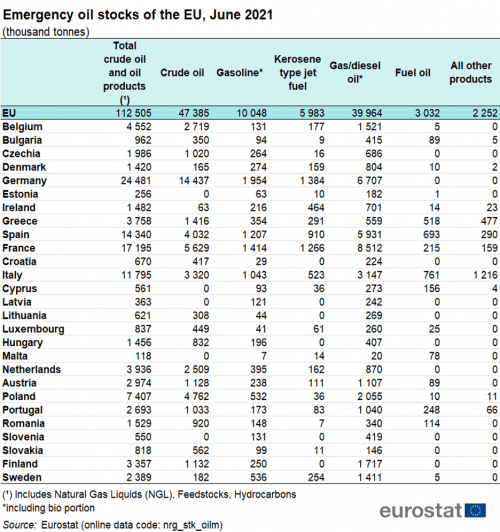
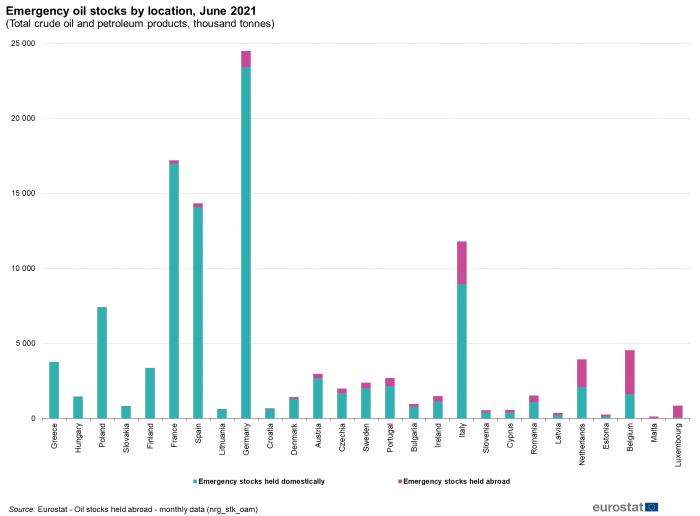
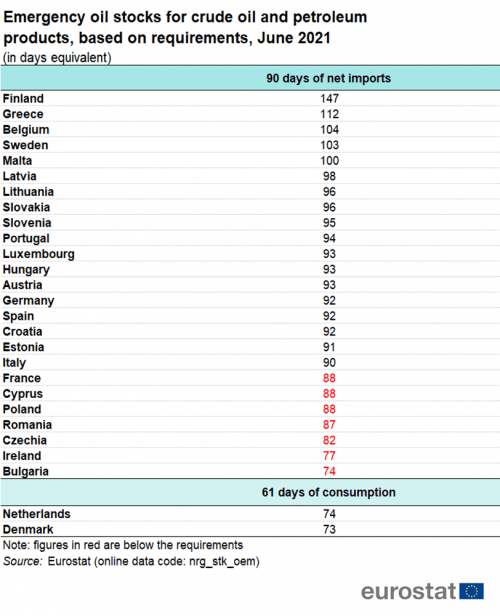
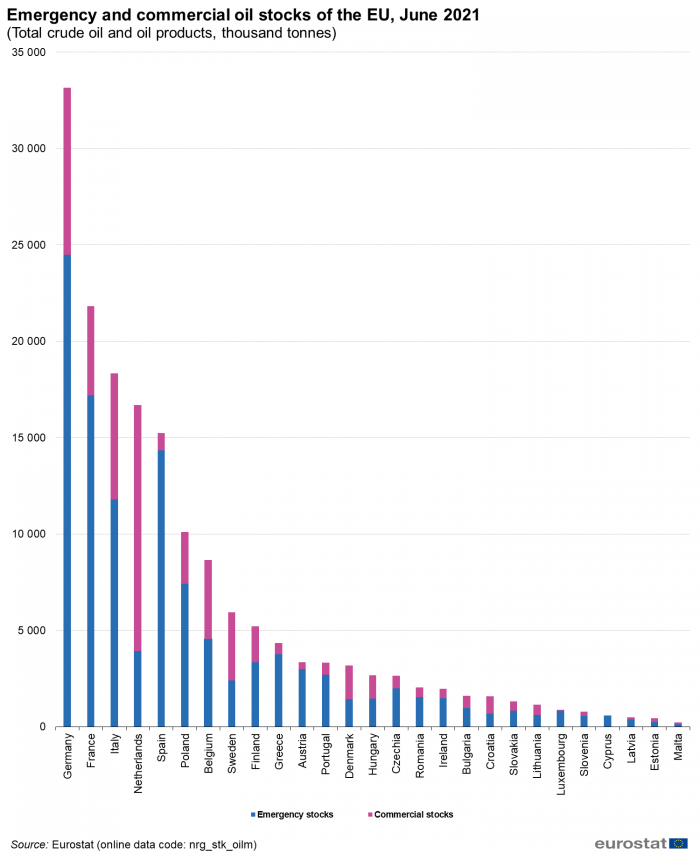
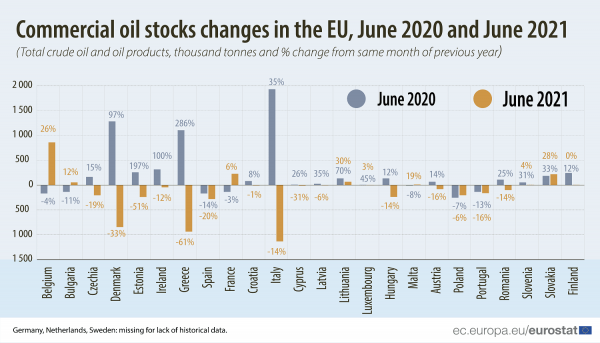





Leave a Reply